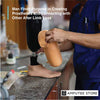MIT-Developed Surgical Technique Makes Prosthetic Limbs Feel Real
Proprioception—the body's ability to perceive its position in space—is vital because it allows us to control our body's movements precisely. However, during amputation, muscles are cut in a way that removes an individual's proprioception, which causes a sense of disembodiment and increases the rejection rate of prosthetic limbs.

To restore proprioception in amputees, researchers at the Center for Extreme Bionics at the MIT Media Lab have developed a new surgical technique that makes artificial limbs feel like biological limbs. This technique is also known as the agonist-antagonist myoneural interface (AMI), which preserves dynamic muscle relationships within the amputated limb.
The role of agonist-antagonist muscle pairs
The reason amputees lose proprioception is they usually don't have agonist (contracting) and antagonist (relaxing or lengthening) muscle pairs, which are responsible for controlling limb movement. For example, when the biceps contract (agonist), the triceps relax (antagonist). Without these muscle pairs working together, it's difficult to sense where artificial limbs are placed or the amount of force being put on them. Without agonist-antagonist muscle pairs, it's difficult for an individual to manipulate objects or successfully balance.
MIT researchers recreated the agonist-antagonist muscle pairs through this new surgical technique, utilizing nerve signals undamaged after amputation. They connected the nerves to the muscle pairs, which were taken from other parts of the body into the residual limb.

Image courtesy of MIT News
With this framework, patients don't have to think about controlling their prosthetic limbs; they simply need to imagine moving their phantom limbs, and signals will be sent via nerves to the surgically constructed muscle pairs. Implanted muscle electrodes will sense these signals. The brain is highly capable of remapping, it will quickly adapt to the new interface and interpret the force, muscle length, and speed based on the signals. The brain interprets this information as a natural proprioception.
First patient
The AMI was first implemented surgically in a below-knee (BK) patient at Brigham and Women's Faulkner Hospital in Boston. Two AMIs were constructed in the residual limb at the time of initial amputation—one controls the prosthetic ankle joint, the other controls the prosthetic subtalar joint.
An advanced prosthetic limb was constructed at MIT, which was electrically linked to the patient's peripheral nervous system using electrodes placed over each AMI muscle after the amputation.
The researchers then compared the patient's movement with four participants who underwent a traditional BK amputation procedure and used the same advanced prosthetic leg.
The team found that the AMI patient had more stable control over the prosthetic device's movement and was able to move more efficiently than those with conventional amputation.
Furthermore, as the patients with traditional amputation reported feeling disconnected to their prostheses, the AMI patient described feeling the bionic ankle and foot had become part of their own body.
Since this initial procedure, the researchers have carried out AMI procedures on nine other BK amputees. Plans to adapt the technique for above-elbow, below-elbow, and above-knee amputations are currently in the works.
What do you think of this development?









































































